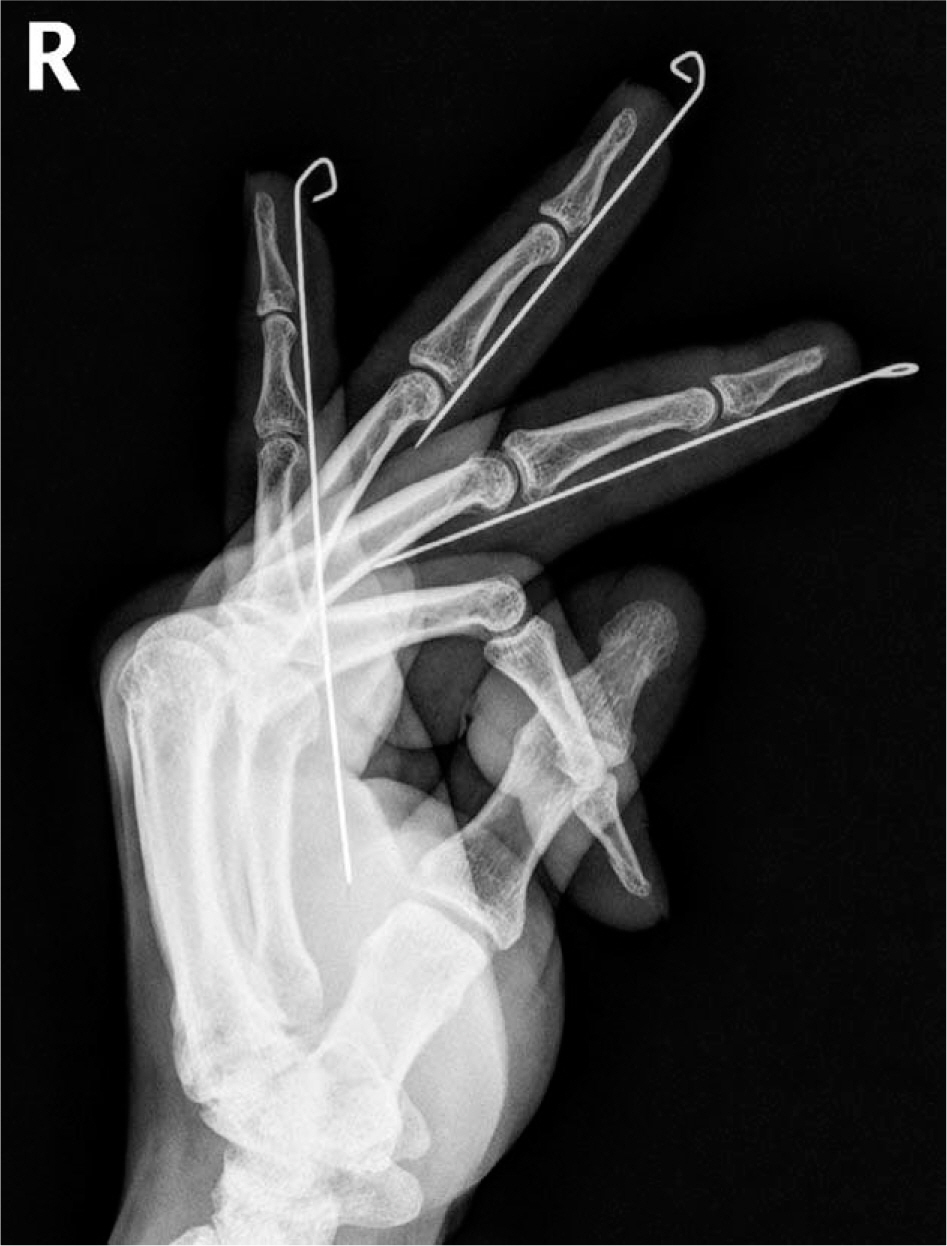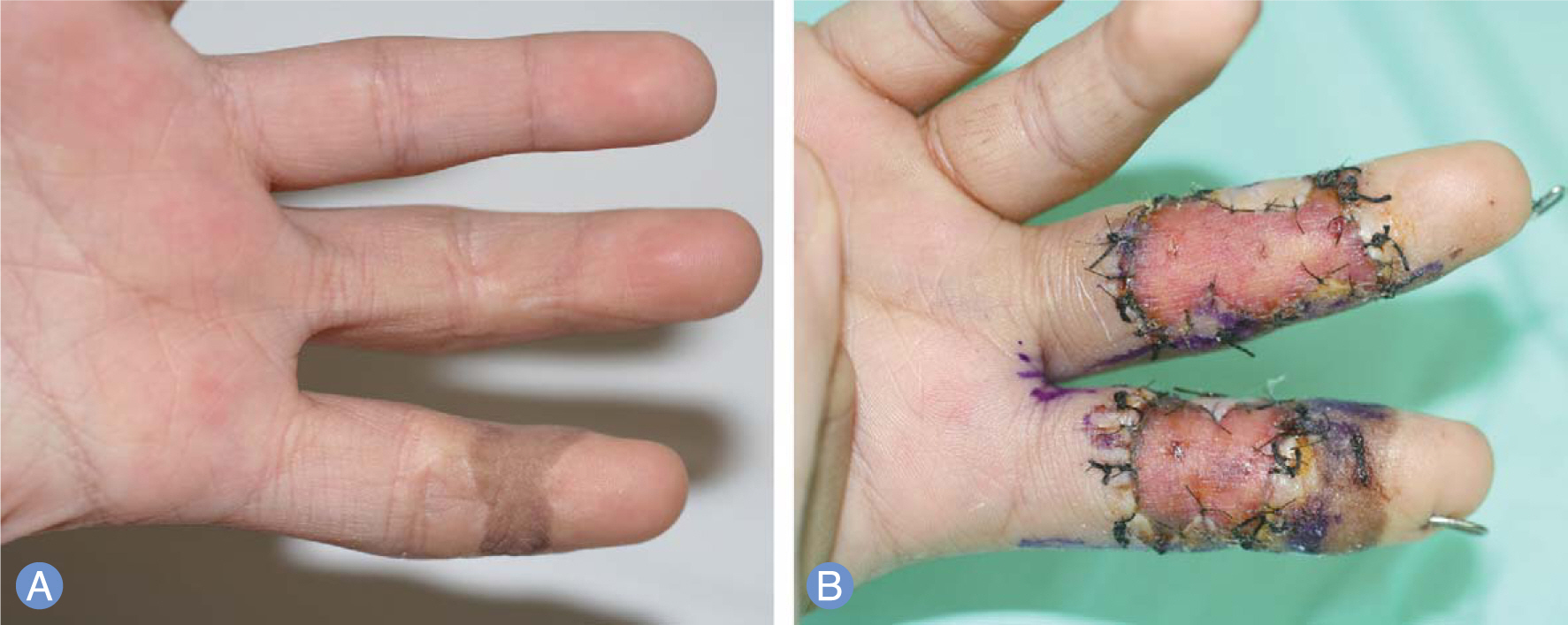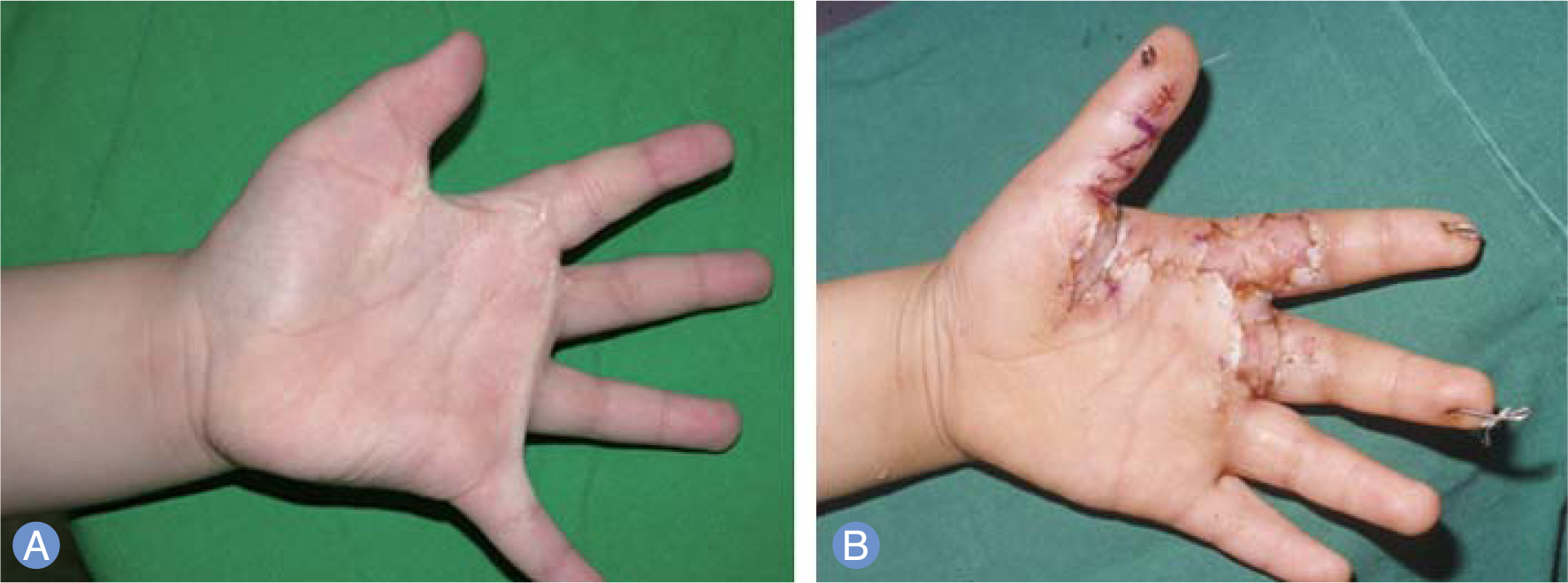J Korean Soc Surg Hand.
2015 Mar;20(1):8-14. 10.12790/jkssh.2015.20.1.8.
Manual Kirschner-Wire Insertion through the Soft Tissue for Finger Immobilization after Scar Contracture Release
- Affiliations
-
- 1Department of Plastic and Reconstructive Surgery, Kyung Hee University School of Medicine, Seoul, Korea. jsburm@gmail.com
- KMID: 2194120
- DOI: http://doi.org/10.12790/jkssh.2015.20.1.8
Abstract
- PURPOSE
Finger immobilization by Kirschner-wire (K-wire) insertion may be used for postoperative stability after release of scar contracture. K-wire insertion through the phalangeal bone requires drilling and can result in joint and/or tendon injury or pain during wire removal. To prevent these problems, we inserted the K-wire through the soft tissue.
METHODS
Seventy-five fingers of 45 patients who underwent reconstruction of scar contracture of the fingers were immobilized by K-wire. After contracture release, just before skin grafting and/or local flap surgery, in full extension of the finger, a K-wire was inserted manually from the fingertip to the proximal phalanx or metacarpal bone through the soft tissue under the phalangeal bone, along the longitudinal axis on the volar side. If the graft site did not have enough soft tissue or the K-wire was felt on the recipient bed, the K-wire was inserted on the dorsal side of the finger. K-wires were manually removed two weeks after surgery.
RESULTS
In most cases, the time to insert the K-wire was 2-3 minutes per finger, and immobilization and stability was maintained for two weeks. In two fingers, the K-wire came out prematurely during wound care; this did not affect the overall outcome. There were no complications due to K-wire insertion or pain during removal.
CONCLUSION
Finger immobilization by K-wire insertion through soft tissue is simple to perform, leads to stable immobilization, has no adding procedure. This method is useful for temporary finger immobilization in full extension.
Keyword
MeSH Terms
Figure
Reference
-
References
1. Achauer BM, Bartlett RH, Furnas DW, Allyn PA, Wingerson EL. Internal fixation in the management of the burned hand. Arch Surg. 1974; 108:814–20.
Article2. Green DP, Hotchkiss RN, Pederson WC. Green’s operative hand surgery. New York: Churchill Livingstone;. 1999.3. Sungur N, Ulusoy MG, Boyacgil S, et al. Kirschner-wire fixation for postburn flexion contracture deformity and consequences on articular surface. Ann Plast Surg. 2006; 56:128–32.
Article4. Larson DL, Evans EB, Abston S, Lewis SR. Skeletal suspension and traction in the treatment of burns. Ann Surg. 1968; 168:981–5.
Article5. Kalliainen LK, Drake DB, Edgerton MT, Grzeskiewicz JL, Morgan RF. Surgical management of the hand in Freeman-Sheldon syndrome. Ann Plast Surg. 2003; 50:456–62.
Article6. Jang YC, Kwon OK, Lee JW, Oh SJ. The optimal management of pediatric steam burn from electric rice-cooker: STSG or FTSG? J Burn Care Rehabil. 2001; 22:15–20.
Article7. Stern PJ, Neale HW, Graham TJ, Warden GD. Classification and treatment of postburn proximal interphalangeal joint flexion contractures in children. J Hand Surg Am. 1987; 12:450–7.
Article8. Galanakis I, Aligizakis A, Katonis P, Papadokostakis G, Stergiopoulos K, Hadjipavlou A. Treatment of closed unstable metacarpal fractures using percutaneous transverse fixation with Kirschner wires. J Trauma. 2003; 55:509–13.
Article
- Full Text Links
- Actions
-
Cited
- CITED
-
- Close
- Share
- Similar articles
-
- Preserved Superficial Fat Skin Composite Graft for Correction of Burn Scar Contracture of Hand
- Kirschner Wire Fixation for Immobilization of the Thenar Flap in an Uncooperative Pediatric Patient: A Case Report
- Sensate Medial Plantar Free Flap Transfer and Adductor Pollicis Myotomy for Treatment of Palmar Burn Scar Contracture
- An Experimental Study of the Effect of Kirschner-wire and Screw insertion upon the Epiphyseal Plate of the Distal Femur in the Growing Rabbit
- Reverse forearm flap as a soft tissue coverage after release of scar contracture of the hand





